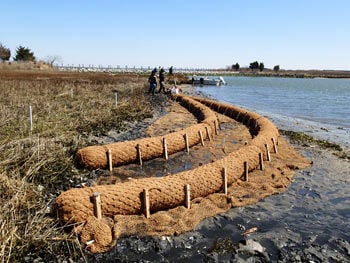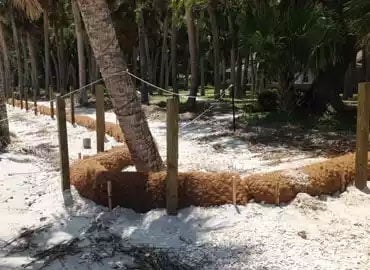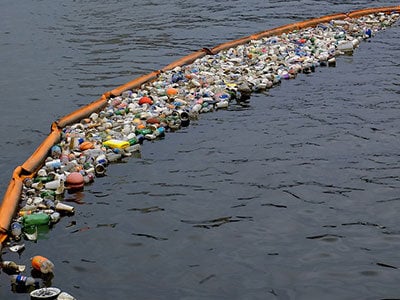Coir Logs for
Erosion Control
Coir logs, also known as coir rolls, are biodegradable erosion control products made from densely packed coconut fibers encased in coir netting. They are widely used to stabilize slopes, shorelines, and stream banks, promoting vegetation growth and preventing soil erosion.
Coir Logs in Erosion Control
Coir logs offer a natural and eco-friendly solution to erosion control. Their use helps protect land from the detrimental effects of erosion while supporting the establishment of vegetation, improving soil stability, and enhancing the overall health of ecosystems.
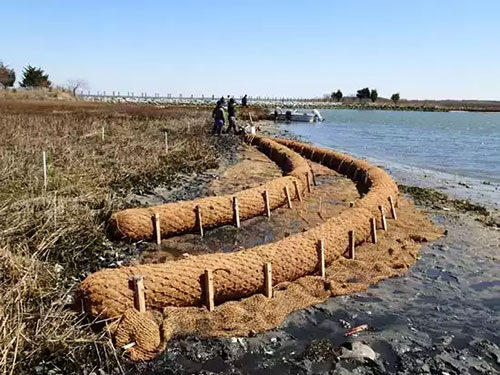
Coir Logs: Highly Effective for Erosion Control
Coir logs are an environmentally friendly and highly efficient solution for combating soil erosion. Crafted from natural coconut fibers, these logs are bound together with coir netting to form a robust, biodegradable barrier that stabilizes soil and encourages plant growth. Perfect for slopes, shorelines, and stream banks, coir logs reduce water runoff velocity and trap sediment, effectively preventing soil erosion. Easy to install and maintain, coir logs offer a sustainable approach to erosion control, enhancing soil quality and promoting a healthy ecosystem over time. At One Clarion, we provide premium coir logs designed to deliver long-lasting protection for your erosion control needs.
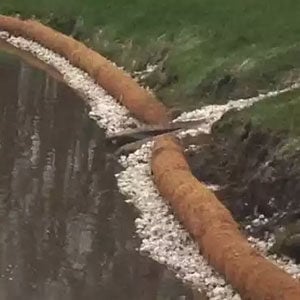
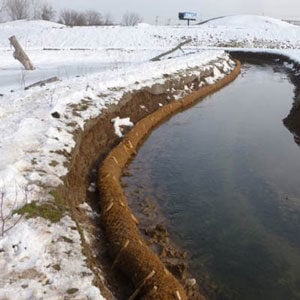

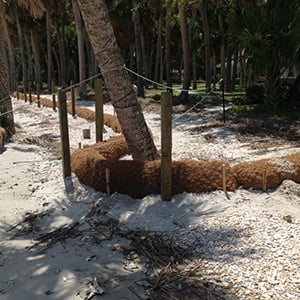
Coir Log Features
Slope Stabilization
Preventing Soil Erosion: Coir logs are placed along slopes to prevent soil erosion by reducing runoff velocity and trapping sediments.
Supporting Vegetation: The logs create a favorable environment for vegetation growth, which helps stabilize the slope over time.
Shoreline Protection
Wave Energy Reduction: Coir logs absorb and dissipate wave energy, reducing the impact on shorelines and preventing erosion.
Habitat Restoration: They provide a natural habitat for aquatic and shoreline plants, supporting biodiversity.
Stream Bank Stabilization
Reducing Erosion: Coir logs help stabilize stream banks by trapping sediments and reducing the erosive force of flowing water.
Enhancing Water Quality: By preventing soil erosion, coir logs help maintain water quality in streams and rivers.
Wetland Restoration
Supporting Native Plants: Coir logs are used to create a stable environment for native wetland plants, promoting ecosystem restoration.
Improving Soil Structure: The addition of organic matter from decomposing coir logs improves soil structure and fertility.
Coir Log Benefits
Can be Joined Together for Custom Lengths
Coir logs are versatile erosion control solutions that can be easily joined together to achieve the desired length for your project. This feature allows you to create a continuous barrier along riverbanks, ensuring comprehensive shoreline protection and erosion control. By interconnecting multiple coir logs, you can effectively cover extensive areas, providing a uniform and sturdy defense against soil displacement and water flow.
Resist Flowing Water
Designed to withstand the erosive forces of flowing water, coir logs are highly effective for bank stabilization. Their durable construction allows them to be placed along stream banks, rivers, and other water bodies without degrading quickly. The natural coconut fibers are densely packed to form a resilient structure that resists wear and tear, ensuring long-term protection against erosion caused by moving water.
Long-Lasting, Provide Extended Support
Coir logs are engineered with a densely packed interior, offering robust and long-lasting support for various erosion control applications. This dense construction helps to build up banks and shores, creating a firm support system that significantly reduces soil erosion over an extended period. The longevity of coir logs ensures that they continue to protect and stabilize your site, promoting the establishment of vegetation and the natural recovery of the ecosystem.
Real-World Application: Coir Logs
Customer's Installation

Customer's Installation

Installation and Maintenance
Installing coir logs is easy. You simply start by clearing the installation area of any obstructions like rocks, branches, or stumps that could prevent the logs from laying flush against the soil. Dig a trench that matches the log’s length and is deep enough to bury two-thirds of its height. Place the coir log into the trench and drive environmentally friendly stakes into the downslope side of the log every 2 to 3 feet to secure it.
For enhanced erosion control, you can join multiple coir logs end-to-end, each in its own trench. Fill the area above the logs with soil to ensure they sit tightly against the ground. When positioning multiple logs side by side, use coir twine to bind the adjoining ends securely to eliminate gaps between them.
To encourage new vegetation growth near water bodies such as rivers, streams, or lakeshores, apply seeded soil just above the coir logs on the side away from the water. As plants grow from the seeds, the coir logs will naturally biodegrade into the soil while continuing to provide erosion control.
Since coir logs do not require any non-natural additives, they are environmentally friendly and safe for wildlife.
Maintaining it involves regular inspections and upkeep to ensure long-term effectiveness. Check the logs routinely, especially after heavy rain, for signs of displacement or damage. Re-secure any loose logs and replace damaged sections promptly. Support vegetation growth by re-seeding areas where plants have not established, as healthy vegetation further stabilizes the soil. Clear any accumulated debris from around the logs to maintain their functionality. Regular maintenance ensures the coir logs continue to provide effective erosion control and soil stabilization.
Related Products
Let's Connect
Fill out the form below and we will get back with you within 24 hours. For immediate assistance, call: 863-261-8388 during normal business hours. We offer quick lead-times, and ship across the US and internationally. Fast, affordable shipping from warehouses nationwide.

